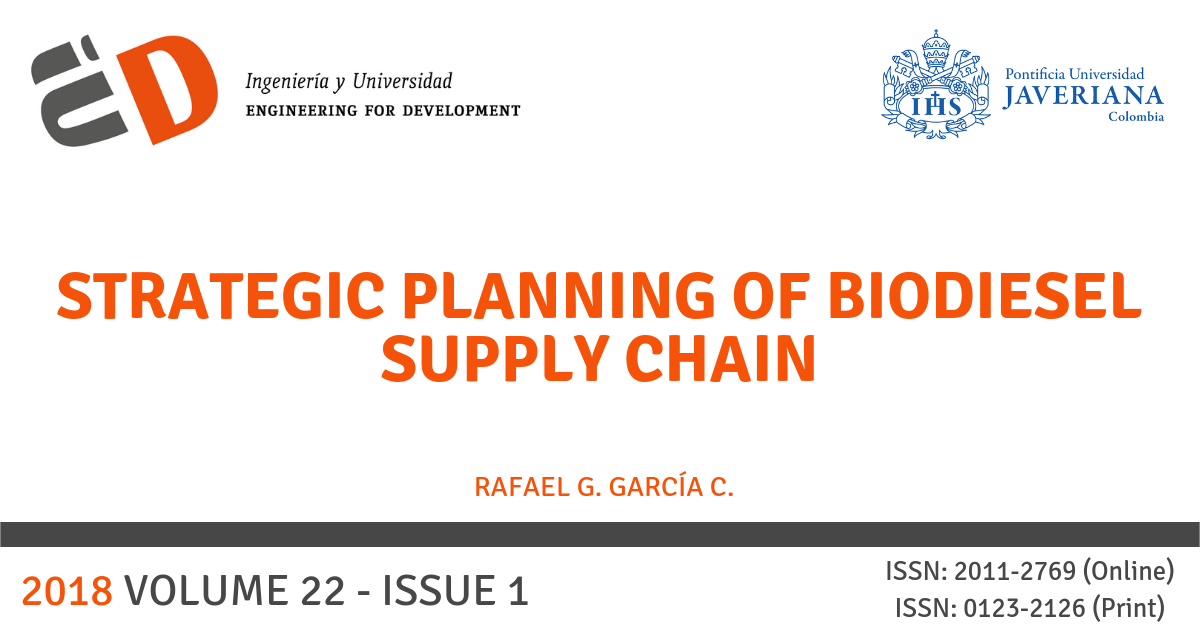Strategic planning of biodiesel supply chain

##plugins.themes.bootstrap3.article.details##
Objective: A stochastic bi-objective Mixed Integer Problem (MIP) model of biodiesel supply chain networks is presented, ultimately intended to support strategic decisions of stakeholders. Materials and Methods: The bi-objective MIP model aims to minimize the total cost and environmental impact of five chain echelons, taking into consideration the following constraints: economies of scale, location of facilities, production capacity, raw material supply, product demand, bill of materials and mass balance. The solution procedure resorts to chance constraints, valid constraints and the ε-constraint method. Results and Discussion: The CPU times for the optimal solution of the problem instances show very good values. Computational experiments allowed assessing the performance of the solution procedure. Conclusion: The current approach to the modeling of the biodiesel supply chain may serve as the basis of future similar works and associated solution procedures, thus facilitating decision-making at different supply chain stages. The approach fosters the development of new solution approaches such as adequate acceleration; heuristics and meta-heuristics; branch and cut methods;and Lagrangian, Benders and Danzing-Wolfe decompositions. These new approaches are intended to allow comparisons in terms of computational performance level, optimality gap, CPU time and memory usage.
Biodiesel, oil palm, logistics, supply chain, mathematical programming, optimizationBiodiesel, aceite de palma, logística, cadena de abastecimiento, programación matemática, optimización
[2] L. Zhang and G. Hu, “Supply chain design and operational planning models for biomass to drop-in fuel production,” Biomass and bioenergy, vol. 58, pp. 238-250, Nov. 2013. https://doi.org/10.1016/j.biombioe.2013.08.016.
[3] S. Gold and S. Seuring, “Supply chain and logistics issues of bio-energy production,” J. Cleaner Prod., vol. 19, no. 1, pp. 32-42, Jan. 2011. https://doi.org/10.1016/j.jclepro. 2010.08.009.
[4] B. Sharma, R. G. Ingalls, C. L. Jones, and A. Khanchi. “Biomass supply chain design and analysis: Basis, overview, modeling, challenges, and future,” Renew. Sustain. Energy Rev., vol. 24, pp. 608–627., Aug. 2013. https://doi.org/10.1016/j.rser.2013.03.049.
[5] M. Eskandarpour, P. Dejax, J. Miemczyk, and O. Péton, “Sustainable supply chain network design: an optimization-oriented review,” Omega, vol. 54, pp. 11–32, Jul. 2015. http://dx.doi.org/10.1016/j.omega.2015.01.006.
[6] F. You, and B. Wang. “Life cycle optimization of biomass-to-liquid supply chains with distributed-centralized processing networks,” IEC Res., vol. 50, no. 17, pp. 10102–10127, Jun. 2011. http://doi: 10.1021/ie200850t.
[7] I. Burton. “Report on reports: Our common future. The world commission on environment and development,” Environ: Sci. Policy Sustain. Develop., vol. 29, no. 5, pp. 25-29, 1987. http://dx.doi.org/10.1080/00139157.1987.9928891.
[8] R. G.García Cáceres, A. Núñez Moreno, T. Ramírez Ortíz, and S. Jaimes Suárez, “Caracterización de la fase Upstream de las Cadenas de Valor y de Abastecimiento de Palma de Aceite en Colombia,” DYNA, vol. 80, no. 179, pp. 79-89, 2013.
[9] E. Gutiérrez Franco, A. I. Cadena Monroy, J. Montoya, and F. Palacios, “Metodología de optimización para la toma de decisiones biodiesel en Colombia,” Cuadernos de Administración, vol 24, no. 43, pp. 59-87, Jul-Dec. 2011.
[10] E. Gutiérrez Franco, A. Cadena, F. Palacios, and R. G. García Cáceres, “Planificación estratégica del sector de biodiesel en Colombia,” in XIV Latin-Ibero-American Congress on Oper. Res. – Book of Extended Abstracts (CLAIO 2008), Cartagena de Indias, Colombia, 2008.
[11] R. G. García Cáceres, M. E. Martínez Avella, and F. Palacios Gómez, “Tactical optimization of the oil palm agribusiness supply chain,” App. Math. Modell., vol. 39, no. 20, pp. 6375-6395, Oct. 2015.http://dx.doi.org/10.1016/j.apm.2015.01.031.
[12] R. Babazadeh, “Optimal design and planning of biodiesel supply chain considering nonedible feedstock,” Renew. Sustain. Energy Rev., vol. 75, pp. 1089-1100, Aug. 2017. https://doi.org/10.1016/j.rser.2016.11.088.
[13] S. Domínguez García, C. Gutiérrez Antonio, J. A. De Lira-Flores, J. M. Ponce -Ortega, “Optimal planning for the supply chain of biofuels for aviation in Mexico,” Clean Technol. Environ. Policy, vol. 19, no.5, pp. 1387-1402, Jul. 2017. https://doi.org/10.1007/s10098-017-1337-x.
[14] R. Babazadeh, J. Razmi, M. Rabbani, and M. S. Pishvaee. “An integrated data envelopment analysis-mathematical programming approach to strategic biodiesel supply chain network design problem,” J. Cleaner Prod., vol. 147, pp. 694-707, Mar. 2017. https://doi.
org/10.1016/j.jclepro.2015.09.038.
[15] N. Escobar, C. Manrique-de-Lara-Peñate, N. Sanjuán, G. Clemente, and S. Rozakis. “An agro-industrial model for the optimization of biodiesel production in Spain to meet the European GHG reduction targets,” Energy, vol. 120, pp. 619-631, Feb. 2017. https://doi.org/10.1016/j.energy.2016.11.111.
[16] S. Mohseni and M. S. Pishvaee. “A robust programming approach towards design and optimization of microalgae-based biofuel supply chain,” Comp.Ind. Eng., vol. 100, pp. 58-71, Oct. 2016. https://doi.org/10.1016/j.cie.2016.08.003.
[17] A. Azadeh, and H. V. Arani. “Biodiesel supply chain optimization via a hybrid system dynamics-mathematical programming approach,” Renew. Energy, vol. 93, pp. 383-403, Aug. 2016. https://doi.org/10.1016/j.renene.2016.02.070.
[18] Departamento Nacional de Planeación-DNP. (2008). Conpes 3510: Lineamientos de política para promover la producción sostenible de biocombustibles en Colombia. [Online]. Available: http://www.minambiente.gov.co/images/normativa/conpes/2008/conpes_3510_2008_.pdf
[19] A. Charnes and W. W. Cooper, “Chance-constrained programming,” Manage. Sci., vol. 6, no. 1, pp. 73-79, Oct. 1959. http://dx.doi.org/10.1287/mnsc.6.1.73
[20] L. A. Wolsey. Integer Programming. New York: John Wiley & Sons, 1998.
[21] G. Mavrotas, “Effective implementation of the ε constraint method in multi-objective mathematical programming problems,” App. Math. Comp., vol. 213, no. 2, pp. 455–465, Jul. 2009. https://doi.org/10.1016/j.amc.2009.03.037.
[22] M. S. Pishvaee, and J. Razmi, “Environmental supply chain network design using multiobjective fuzzy mathematical programming,” App. Math. Modelling, vol. 36, no. 8, pp. 3433–3446. https://doi.org/10.1016/j.apm.2011.10.007.

